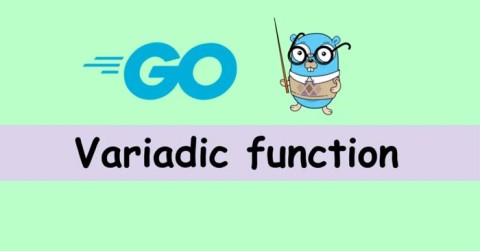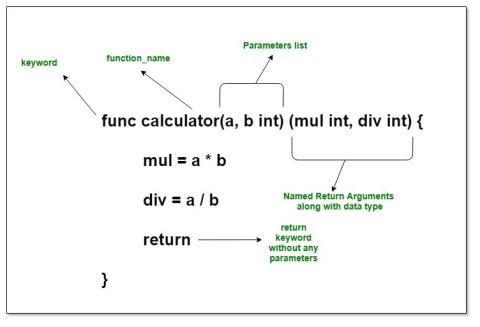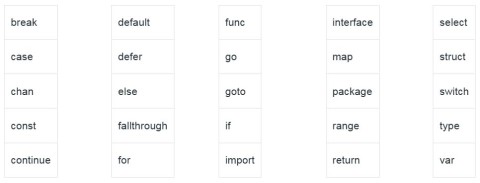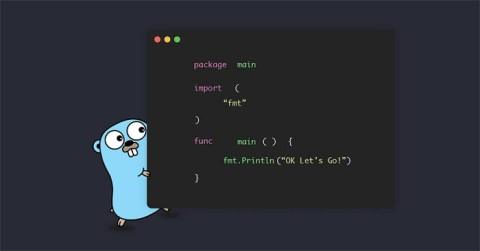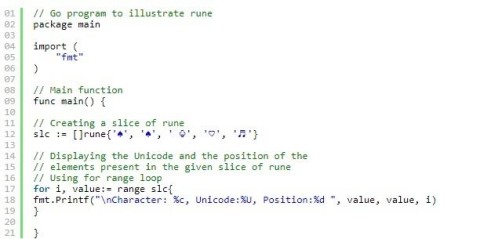Cómo usar constantes en Golang

¿Qué es Constante o Const en Golang? Esto es lo que necesita saber sobre el uso de constantes en Go.
En Golang , las estructuras (o structs) nos permiten agrupar elementos de diferentes tipos en una sola unidad, lo que resulta útil para modelar entidades del mundo real. Las estructuras anónimas en Golang son estructuras temporales sin nombre que se utilizan para fines únicos, mientras que los campos anónimos permiten la incorporación de campos sin nombre.

Por ejemplo:
package main
import "fmt"
// struct học sinh với cấu trúc và trường ẩn danh
type Student struct {
struct { // Cấu trúc bên trong ẩn danh cho thông tin cá nhân
name string
enrollment int
}
GPA float64 // Trường chuẩn
}
func main() {
student := Student{
struct {
name string
enrollment int
}{
name: "A",
enrollment: 12345,
},
GPA: 3.8,
}
fmt.Println("Name:", student.name)
fmt.Println("Enrollment:", student.enrollment)
fmt.Println("GPA:", student.GPA)
}
Sintaxis:
variable := struct {
field1 dataType1
field2 dataType2 # Cấu trúc ẩn danh
// Trường bổ sung khi cần
}{value1, value2}
type StructName struct {
dataType1
dataType2 # Trường ẩn danh
// Trường ẩn danh bổ sung
}Estructuras anónimas en Go
Las estructuras anónimas en Go se definen sin un nombre y son útiles para crear estructuras temporales y desechables. Aquí está el ejemplo de sintaxis y código.
Sintaxis:
variable := struct {
field1 dataType1
field2 dataType2
// Các trường bổ sung khi cần
}{value1, value2}Por ejemplo:
package main
import "fmt"
// Cấu trúc sinh viên với cấu trúc bên trong ẩn danh cho thông tin cá nhân
type Student struct {
personalDetails struct { // Cấu trúc ẩn danh bên trong cho thông tin cá nhân
name string
enrollment int
}
GPA float64 // Trường chuẩn
}
func main() {
// Khởi tạo cấu trúc bên trong cho student
student := Student{
personalDetails: struct {
name string
enrollment int
}{
name: "A",
enrollment: 12345,
},
GPA: 3.8,
}
// Hiện giá trị
fmt.Println("Name:", student.personalDetails.name)
fmt.Println("Enrollment:", student.personalDetails.enrollment)
fmt.Println("GPA:", student.GPA)
}
Resultado:
Name: A
Enrollment: 12345
GPA: 3.8Este código define una estructura Estudiante con una estructura personalDetails anónima dentro, que almacena el nombre y la información de registro. Luego inicialice el estudiante con valores para estos campos e imprímalos.
Campos anónimos
Los campos anónimos en Go le permiten definir campos sin nombres explícitos, solo se especifican sus tipos. Esto es útil cuando los campos siguen naturalmente al nombre del tipo.
Sintaxis
type StructName struct {
dataType1
dataType2
// Additional anonymous fields
}Por ejemplo:
package main
import "fmt"
// Cấu trúc học sinh bằng các trường ẩn danh
type Student struct {
int // Số đăng ký (trường ẩn danh)
string // Tên trường ẩn danh
float64 // GPA (trường ẩn danh)
}
func main() {
// Khởi tạo struct học sinh với các trường ẩn danh
student := Student{12345, "A", 3.8}
// Hiện giá trị
fmt.Println("Enrollment:", student.int)
fmt.Println("Name:", student.string)
fmt.Println("GPA:", student.float64)
}
Resultado:
Enrollment: 12345
Name: A
GPA: 3.8Aquí, los tipos de datos ( int, string, float64 ) actúan como nombres de campo, por lo que el acceso a los valores depende de los tipos.
Puntos importantes a recordar sobre los campos anónimos en Golang
1. Requisito único: no se pueden utilizar dos campos del mismo tipo en una estructura. Por ejemplo:
type InvalidStudent struct {
int
int // Error: duplicate type
}2. Combinación de campos con nombre y anónimos: puedes combinar campos anónimos y con nombre en una estructura.
type Student struct {
id int // Named field
int // Anonymous field
}¿Qué es Constante o Const en Golang? Esto es lo que necesita saber sobre el uso de constantes en Go.
Las funciones variádicas en Go le permiten pasar una cantidad variable de argumentos a una función. Aquí encontrará todo lo que necesita saber sobre las funciones volátiles en Golang.
En Golang, los parámetros de retorno con nombre a menudo se denominan parámetros con nombre. Golang permite nombrar los parámetros de retorno o los resultados de las funciones en la firma o definición de la función.
Palabra clave: Las palabras clave son palabras en un lenguaje que se utilizan para algún proceso interno o representan alguna acción predefinida. Aquí tienes lo que necesitas saber sobre las palabras clave en Golang.
El tipo de datos especifica el tipo de datos que puede contener una variable Go válida. En el lenguaje Go, los tipos se dividen en cuatro categorías como sigue:
Go admite dos formas principales de pasar argumentos: pasar por valor y pasar por referencia. Go utiliza el paso por valor de manera predeterminada.
En el lenguaje Go, se permite devolver múltiples valores de una función, utilizando la declaración de retorno. En otras palabras, en una función, una declaración de retorno puede devolver múltiples valores.
Golang, como la mayoría de los otros lenguajes de programación, tiene una declaración switch. Aquí se explica cómo utilizar la declaración switch en Golang.
En este artículo, aprenderemos cómo utilizar el caso predeterminado para evitar el bloqueo. Pero primero, ¿averigüemos qué es el caso de bloqueo cuando se utiliza el comando de selección de Golang?
¿Qué son las Runas en Golang? ¿Cómo usar Runas en Golang? El artículo te dirá la respuesta.
Los operadores nos permiten realizar diferentes tipos de operaciones sobre los operandos. En el lenguaje Go, los operadores se pueden clasificar según sus diferentes funciones.
_(guión bajo) en Golang se llama Identificador en blanco. El identificador es un nombre definido por el usuario de los componentes del programa que se utiliza con fines de identificación.
¡Hola Mundo! es el primer programa básico en cualquier lenguaje de programación. Puedes escribir este primer programa en Golang siguiendo los pasos a continuación.
Golang se puede instalar fácilmente en Windows. A continuación se muestra una guía detallada paso a paso para instalar Golang en Windows.
En este artículo, te guiaremos sobre cómo recuperar el acceso a tu disco duro cuando falla. ¡Sigamos!
A primera vista, los AirPods parecen iguales a cualquier otro auricular inalámbrico. Pero todo cambió cuando se descubrieron algunas características poco conocidas.
Apple ha presentado iOS 26, una importante actualización con un nuevo diseño de vidrio esmerilado, experiencias más inteligentes y mejoras en aplicaciones conocidas.
Los estudiantes necesitan un tipo específico de portátil para sus estudios. No solo debe ser lo suficientemente potente como para desempeñarse bien en su especialidad, sino también lo suficientemente compacto y ligero como para llevarlo consigo todo el día.
Agregar una impresora a Windows 10 es sencillo, aunque el proceso para dispositivos con cable será diferente al de los dispositivos inalámbricos.
Como sabes, la RAM es un componente de hardware muy importante en una computadora, ya que actúa como memoria para procesar datos y es el factor que determina la velocidad de una laptop o PC. En el siguiente artículo, WebTech360 te presentará algunas maneras de detectar errores de RAM mediante software en Windows.
Los televisores inteligentes realmente han conquistado el mundo. Con tantas funciones excelentes y conectividad a Internet, la tecnología ha cambiado la forma en que vemos televisión.
Los refrigeradores son electrodomésticos familiares en los hogares. Los refrigeradores suelen tener 2 compartimentos, el compartimento frío es espacioso y tiene una luz que se enciende automáticamente cada vez que el usuario lo abre, mientras que el compartimento congelador es estrecho y no tiene luz.
Las redes Wi-Fi se ven afectadas por muchos factores más allá de los enrutadores, el ancho de banda y las interferencias, pero existen algunas formas inteligentes de mejorar su red.
Si quieres volver a iOS 16 estable en tu teléfono, aquí tienes la guía básica para desinstalar iOS 17 y pasar de iOS 17 a 16.
El yogur es un alimento maravilloso. ¿Es bueno comer yogur todos los días? Si comes yogur todos los días, ¿cómo cambiará tu cuerpo? ¡Descubrámoslo juntos!
Este artículo analiza los tipos de arroz más nutritivos y cómo maximizar los beneficios para la salud del arroz que elija.
Establecer un horario de sueño y una rutina para la hora de acostarse, cambiar el despertador y ajustar la dieta son algunas de las medidas que pueden ayudarle a dormir mejor y despertarse a tiempo por la mañana.
¡Alquiler por favor! Landlord Sim es un juego de simulación para dispositivos móviles iOS y Android. Jugarás como propietario de un complejo de apartamentos y comenzarás a alquilar un apartamento con el objetivo de mejorar el interior de tus apartamentos y prepararlos para los inquilinos.
Obtén el código del juego Bathroom Tower Defense de Roblox y canjéalo por emocionantes recompensas. Te ayudarán a mejorar o desbloquear torres con mayor daño.
